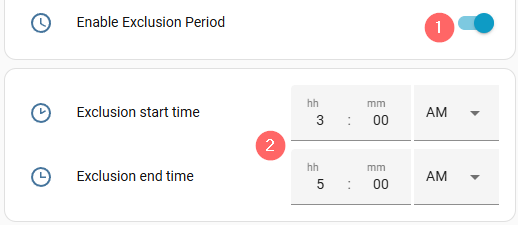Exclusion Period
There may be times when you want to disable energy management, for example, you want to charge your EV.
The Exclusion Period setting on the PV Configuration page allows you to set a period of time when Energy Manager will change to a mode that will allow you to draw power from the grid, without reverting back to Self-Consumption mode every 5 minutes, and with minimal power draw from the battery.
What does the exclusion period do?
The exclusion period will put the system in "take from grid" mode. This will mean that your battery is set to NOT discharge, but any power draw from the house, including charging your EV, will come straight from the grid.
There are two things wrong with dumping the energy stored in your home battery into your EV battery. Firstly, there are larger power inefficiencies. If you charge your battery from the sun, and then later dump this energy into your car battery, you are losing power due to power inefficiencies. You will lose power when you charge your home battery, and you lose more power when you discharge into your EV battery. Secondly, if we take into consideration the fact that an EV battery is generally a lot larger than a house battery, and all batteries have a finite number of charge/discharge cycles, if you dump your stored battery energy into the car you are using additional battery cycles. Warranties are generally based around the number of cycles, not a time period. Manufactures do talk about a "10 year warranty", etc, but if you read the fine print of the warranty, this is based on, for example, 4,000 charge/discharge cycles - up to the specified time period - so whichever comes first. If you are dumping your house battery into your car, you are speeding up the charge/discharge cycles and potentially shortening your warranty period.
The ideal time to charge your EV is when the grid is cheap and taken from the grid. However, if you've got excess solar generation, it makes sense to use this generation even with some inefficiences, since chances are you are curtailing the excess anyway. However, if your car is away from your premises during the day (which is often the case), then you can't do this, so this is when the exclusion period comes in handy. It is more efficient to charge directly from the grid than to transfer energy between batteries.
Setting the exclusion Period
Open the PV Configuration page (cog symbol).

- Enable the Exclusion period toggle
- The exclusion period start and end times will be displayed. Edit these appropriately.
Charging an EV directly from the grid is the most efficient method, while charging from a solar-powered home battery is the least efficient. This is because each time electricity is converted (e.g., from AC to DC) or stored, some energy is lost as heat. Note that DC-coupled batteries still lose efficiency, but are more efficient than AC-coupled batteries.
- Charging Directly from the Grid
This is the most efficient method because it involves only one energy conversion. Typical Efficiency: Around 90%. Example: For every 10 kWh you pull from the grid, about 9 kWh makes it into your EV's battery.
- Charging Directly from Solar Panels
This method is less efficient than the grid because it adds an extra conversion step. Typical Efficiency: Around 85%. Example: For every 10 kWh your solar panels generate, about 8.5 kWh makes it into your EV's battery.
- Charging from a Solar-Charged Home Battery
This is the least efficient method because it involves storing and retrieving energy, which adds significant losses. Typical Efficiency: Around 77%. Example: If you store 10 kWh of solar energy in your home battery, only about 7.7 kWh will make it into your EV's battery after all the conversions.
You can go directly to the other sections of this configuration page below: